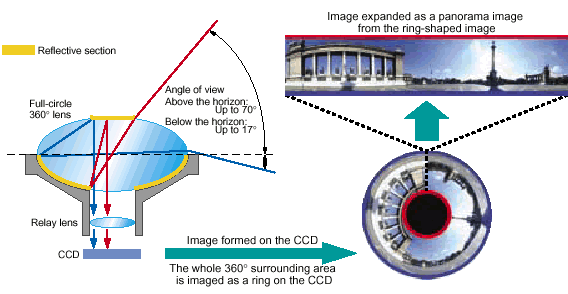Sony’s 360 Degree Panorama Camera
(Sony) Until now, taking a 360 degree panorama with a normal lens has required taking multiple shots while rotating the camera slowly and then combining (“stitching”) those shots together to form the panorama.
In contrast, the lens allows the full 360 degree surroundings of the camera to be imaged at the same time with a single lens.
Sony has now developed a camera module that uses this 360 degree full-circle lens, and is releasing as commercial products both a camera module that uses a 380K-pixel, 30 fps CCD that outputs a ring-shaped image as a composite video signal as well as a high-resolution camera module that uses a 1.28 MP, 7.5 fps CCD with a built-in panorama expansion processing function.

The mechanism that allows this full-circle 360 degree lens to see all of its surroundings is shown in figure 1. The image of all the surroundings is reflected twice on two reflective surfaces (formed by vapor deposition of aluminum), one in the lower part of the lens and the other at the top and the image is formed in a ring shape on the CCD. This allows everything around the lens to be imaged within a range consisting of 70 degree above the plane of the lens and 17 degree below that plane. (This is close to the area illuminated by a lighthouse. This angle was set when the lens was designed.) This full-circle 360 degree lens has the following main features.
- The whole surrounding area can be imaged with a single lens.
- The area below the plane of the lens can also be imaged.
- This lens design logically results in a depth of field (the range of distances in which objects are in focus) from 0 to infinity. This means that focusing is not required.
- There are no moving structural parts, and pan, tilt, and zoom operations can be implemented in software. This makes maintenance easy, and power consumption low.
- Since images can be formed as long as just the lens section is exposed, the camera module itself can be embedded in a wall or ceiling.






